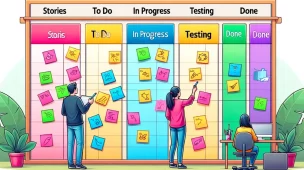Are you tired of feeling overwhelmed by the endless tasks and responsibilities that come with daily life? Do you struggle to stay organized and on top of everything you need to accomplish? If so, it might be time to start using a to-do list. In this article, we’ll explore the benefits of creating a to-do list, and provide you with a step-by-step guide on how to make one that works for you. From using a notebook to a spreadsheet, and even Word, we’ve got you covered.
The Benefits of a To-Do List
Before we dive into the specifics of how to create a to-do list, it’s important to understand why this tool can be so helpful. A well-crafted to-do list can:
- Help you stay organized and focused
- Reduce stress and overwhelm by breaking down tasks into manageable pieces
- Increase productivity by ensuring that important tasks are completed on time
- Improve time management skills by prioritizing tasks effectively
With these benefits in mind, let’s take a look at how to create a to-do list that works for you.
Step 1: Choose Your Medium
The first step in creating a to-do list is to decide where you want to keep it. Some popular options include:
Using a Notebook
A traditional notebook can be a great option for those who prefer to write things down by hand. This method allows for easy customization and flexibility, as you can add or remove tasks as needed. Plus, the act of physically writing things down can help with memory retention.
Using a Spreadsheet
For those who prefer a more digital approach, a spreadsheet can be a useful tool. This method allows for easy sorting and organizing of tasks, as well as the ability to set reminders and deadlines.
here’s an example of a to-do list in a spreadsheet format:
Task Name | Category | Priority | Due Date | Status |
Research project sources | Work | High | 04/15/2023 | In progress |
Call doctor to schedule appointment | Personal | Medium | 04/08/2023 | Not started |
Draft project outline | Work | High | 04/16/2023 | Not started |
Grocery shopping | Personal | Low | N/A | Not started |
Complete weekly report | Work | Medium | 04/14/2023 | In progress |
Attend team meeting | Work | High | 04/13/2023 | Completed |
Schedule time for exercise | Personal | Low | N/A | Not started |
Pay monthly bills | Personal | Medium | 04/20/2023 | Not started |
In this example, the to-do list is organized into columns for task name, category, priority, due date, and status. The task name column includes specific, actionable tasks that need to be completed. The category column indicates whether each task is work-related or personal in nature. The priority column assigns a level of importance to each task, with high-priority tasks being the most urgent. The due date column specifies when each task needs to be completed. Finally, the status column indicates whether each task is in progress, completed, or not yet started.
This spreadsheet format can be helpful for keeping track of multiple tasks and ensuring that they are organized and prioritized effectively. Additionally, using a spreadsheet allows for easy sorting and filtering of tasks based on category, priority, or due date.
Using Word
If you’re looking for a simple, no-frills approach, using a Word document can be a great option. This method allows for easy editing and formatting, and can be printed out or saved digitally for easy access.
Once you’ve decided on your medium, it’s time to move on to step two.
Step 2: Brainstorm Your Tasks
Feeling overwhelmed with all the tasks you have to do? Don’t worry, it’s a common experience. The key is taking the time to properly brainstorm your list of responsibilities and create an organized plan for tackling them. By jotting down each task in full detail and prioritizing accordingly, you’ll be able to make quick work of any daunting-looking job!
As a professional, your to-do list might include a mix of work-related tasks, meetings, appointments, and personal responsibilities. Here are some examples of tasks you might want to include on your list:
- Respond to urgent emails and phone calls
- Attend a meeting with your team to discuss project updates
- Work on a presentation for an upcoming client meeting
- Schedule a doctor’s appointment
- Go grocery shopping for the week
- Follow up with a client about an outstanding invoice
- Submit a report to your supervisor
- Take a lunch break and go for a walk to clear your mind
For a student, your to-do list might include a mix of academic responsibilities, extracurricular activities, and personal tasks. Here are some examples of tasks you might want to include on your list:
- Attend a class and take notes
- Study for an upcoming exam or quiz
- Write a paper or complete a project
- Attend a club meeting or practice for a sports team
- Meet with a tutor or professor for extra help
- Schedule time for exercise or physical activity
- Do laundry or other household chores
- Spend time with friends or family
Remember, when brainstorming your tasks, it’s important to be as comprehensive as possible. This means including even small or seemingly insignificant tasks, as they can add up and contribute to your overall workload. By taking the time to thoroughly brainstorm your tasks, you’ll set yourself up for success when it comes to organizing and prioritizing your to-do list.
Step 3: Categorize Your Tasks
Once you have a comprehensive list of tasks, the next step is to start organizing them. One effective method is to categorize your tasks by type, such as work tasks, personal tasks, and household tasks. This can help you prioritize and manage your time more effectively.
As a professional, categorizing your tasks can help you balance your workload and ensure that you’re allocating your time and resources effectively. Here are some examples of task categories you might use:
- Work tasks: This category might include tasks related to your job, such as responding to emails, attending meetings, and completing projects.
- Personal tasks: This category might include tasks related to your personal life, such as scheduling doctor’s appointments, paying bills, and grocery shopping.
- Professional development: This category might include tasks related to your career growth, such as attending training sessions, networking events, and researching new industry trends.
For a student, categorizing your tasks can help you balance your academic responsibilities with your personal and extracurricular activities. Here are some examples of task categories you might use:
- Academic tasks: This category might include tasks related to your coursework, such as attending classes, studying for exams, and completing assignments.
- Extracurricular activities: This category might include tasks related to clubs or organizations you’re involved in, such as attending meetings or events, and participating in community service projects.
- Personal tasks: This category might include tasks related to your personal life, such as scheduling time for exercise, doing laundry, and spending time with friends or family.
Remember, the key to effective categorization is to tailor it to your individual needs and preferences. By organizing your tasks into categories that make sense for you, you’ll be better equipped to prioritize your time and stay on top of your to-do list.

Step 4: Prioritize Your Tasks
Once you’ve categorized your tasks, it’s important to prioritize them. This can be done by ranking tasks in order of importance, or by assigning deadlines or due dates. It’s important to be realistic about what you can accomplish in a given day or week, so don’t overload yourself with too many tasks.
As a professional, prioritizing your tasks can help you ensure that you’re meeting deadlines and staying on track with your workload. Here are some examples of how you might prioritize your tasks:
- Urgent tasks: These are tasks that need to be completed immediately, such as responding to urgent emails or attending a last-minute meeting.
- Important tasks: These are tasks that have a high impact on your job or career, such as completing a project for a key client or preparing for a presentation.
- Routine tasks: These are tasks that need to be done regularly, such as checking and responding to emails or attending regular team meetings.
For a student, prioritizing your tasks can help you balance your academic responsibilities with your personal and extracurricular activities. Here are some examples of how you might prioritize your tasks:
- High-priority assignments: These are assignments with strict deadlines or that make up a large portion of your grade, such as writing a research paper or preparing for an exam.
- Regular coursework: These are your day-to-day assignments and readings, such as completing a chapter in a textbook or participating in an online discussion.
- Extracurricular activities: These are activities that are important to you, but may not be directly related to your academic coursework, such as participating in a club or sports team.
Remember, when prioritizing your tasks, it’s important to be realistic about what you can accomplish in a given day or week. Don’t overload yourself with too many tasks, or you risk feeling overwhelmed and burned out. By prioritizing effectively, you’ll be able to focus on what’s most important and achieve your goals more efficiently.
Step 5: Create Your To-Do List
Now that you’ve categorized and prioritized your tasks, it’s time to create your to-do list. Depending on your chosen medium, this may involve writing out your tasks by hand, inputting them into a spreadsheet, or typing them out in a Word document. Whatever method you choose, be sure to include all of your tasks in the appropriate categories, and prioritize them as needed.
As you create your to-do list, here are some additional tips to keep in mind:
- Be specific: Instead of writing a vague task like “work on project,” be specific about what you need to do, such as “create project outline” or “draft introduction.”
- Include deadlines: Whenever possible, include a deadline or due date for each task. This will help you stay on track and ensure that important tasks are completed on time.
- Use actionable language: Write your tasks in a way that makes it clear what you need to do. For example, instead of writing “research topic,” write “spend 30 minutes researching sources for paper.”
- Break down larger tasks: If you have a larger task that feels overwhelming, try breaking it down into smaller, more manageable steps. This can help you feel more accomplished and motivated as you make progress.
- Prioritize by category: As you create your to-do list, consider prioritizing tasks within each category as well. This can help ensure that you’re giving appropriate attention to all aspects of your life and workload.
Remember, your to-do list is a tool to help you stay organized and focused. By taking the time to thoughtfully create your list, you’ll be setting yourself up for success and making it easier to achieve your goals.
Step 6: Review and Update Your List
Once you’ve created your to-do list, it’s important to review it regularly and make updates as needed. This can include adding new tasks, removing completed ones, or reprioritizing tasks based on changing circumstances. Regularly reviewing and updating your to-do list can help ensure that you stay on track and accomplish your goals.
To review your to-do list effectively, here are some tips to keep in mind:
- Review daily: Set aside a few minutes each day to review your to-do list and make any necessary updates. This can help you stay on top of your workload and ensure that you’re not missing any important tasks.
- Check off completed tasks: As you complete tasks throughout the day, be sure to check them off your list. This will help you feel a sense of accomplishment and keep track of what you’ve accomplished.
- Reassess priorities: If you find that you’re not able to complete all of your tasks within a given day or week, take a step back and reassess your priorities. Consider reprioritizing tasks based on changing circumstances or moving tasks to another day or week.
- Add new tasks as needed: If you think of a new task that needs to be added to your list, be sure to add it promptly. This will help ensure that you don’t forget about important tasks or responsibilities.
The importance of reviewing and updating your to-do list cannot be overstated. By regularly reviewing your list, you’ll be able to stay on track and ensure that you’re making progress toward your goals. Additionally, updating your list as needed can help you adapt to changing circumstances or unexpected challenges. By taking the time to review and update your to-do list, you’ll be setting yourself up for success and ensuring that you stay organized and on track.
Step 6: Review and Update Your List
Once you’ve created your to-do list, it’s important to review it regularly and make updates as needed. This can include adding new tasks, removing completed ones, or reprioritizing tasks based on changing circumstances. Regularly reviewing and updating your to-do list can help ensure that you stay on track and accomplish your goals.
To review your to-do list effectively, here are some tips to keep in mind:
- Review daily: Set aside a few minutes each day to review your to-do list and make any necessary updates. This can help you stay on top of your workload and ensure that you’re not missing any important tasks.
- Check off completed tasks: As you complete tasks throughout the day, be sure to check them off your list. This will help you feel a sense of accomplishment and keep track of what you’ve accomplished.
- Reassess priorities: If you find that you’re not able to complete all of your tasks within a given day or week, take a step back and reassess your priorities. Consider reprioritizing tasks based on changing circumstances or moving tasks to another day or week.
- Add new tasks as needed: If you think of a new task that needs to be added to your list, be sure to add it promptly. This will help ensure that you don’t forget about important tasks or responsibilities.
The importance of reviewing and updating your to-do list cannot be overstated. By regularly reviewing your list, you’ll be able to stay on track and ensure that you’re making progress toward your goals. Additionally, updating your list as needed can help you adapt to changing circumstances or unexpected challenges. By taking the time to review and update your to-do list, you’ll be setting yourself up for success and ensuring that you stay organized and on track.
Conclusion
In conclusion, creating a to-do list can be a powerful tool for staying organized, reducing stress, and increasing productivity. By following the steps outlined in this article, you can create a to-do list that works for you, whether you prefer a traditional notebook, a digital spreadsheet, or a simple Word document. Just remember to be comprehensive, prioritize effectively, and stay focused on executing your tasks.
FAQs
- How often should I update my to-do list? A: It’s a good idea to review and update your to-do list daily or weekly, depending on your schedule and workload.
- How many tasks should I include on my to-do list? A: This will depend on your individual preferences and workload, but it’s generally a good idea to limit your list to no more than 10-15 tasks per day.
- How do I prioritize my tasks effectively? A: One effective method is to rank tasks by importance or deadline, and to tackle the most critical tasks first.
- What should I do if I don’t complete all of my tasks in a given day? A: Don’t panic – simply carry over any uncompleted tasks to the next day or week, and reprioritize them as needed.
- Can I use a to-do list for long-term planning as well as daily tasks? A: Absolutely! A to-do list can be a useful tool for managing both short-term and long-term goals and tasks.
Resources:
Microsoft To Do Is a good Software and It is Free.












